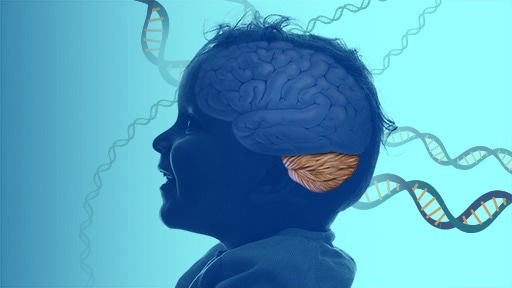Scientists from the National Institutes of Health recently identified a new neurological condition characterized by issues with motor coordination and speech. Their observations were published in the journal npj Genomic Medicine.
 New disease could provide insights into how the cell’s recycling system contributes to a healthy brain. Image Caption: Darryl Leja, National Human Genome Research Institute.
New disease could provide insights into how the cell’s recycling system contributes to a healthy brain. Image Caption: Darryl Leja, National Human Genome Research Institute.
Researchers from NIH’s National Human Genome Research Institute (NHGRI) and Undiagnosed Diseases Program (UDP) identified three children with the condition, two siblings and an unrelated child. All three children had problems with motor coordination and speech, and one of them had abnormalities in the cerebellum, the part of the brain that controls complex movement among other things. Furthermore, all the children had mutations in both copies of the ATG4D gene.
ATG4D contributes to the cellular housekeeping process known as autophagy. Autophagy is the process that cells use to break down and recycle damaged proteins and other defective cell components to remain healthy. Autophagy is a necessary process used by all cells in the body, but neurons are especially reliant on it for survival. Even so, little is known about how ATG4D promotes healthy neurons.
The first hint of ATG4D’s impact on brain health came from a 2015 research in which scientists discovered a genetic neurological disease in Lagotto Romagnolo dogs, an Italian breed recognized for their fluffy coats and truffle-hunting abilities.
The affected dogs displayed abnormal behavior, cerebellar atrophy, problems with motor coordination and eye movement, and ATG4D mutations.
While this 2015 research intrigued scientists’ interest in ATG4D’s role in the brain, researchers had yet to link ATG4D to any neurological disease in humans.
Among genetic diseases, we’ve solved many of the lower hanging fruits. Now, we’re reaching for the higher fruits—genes like ATG4D that are more difficult to analyze—and we have the genomic and cellular tools to do so.”
May Christine Malicdan, MD, PhD, Study Senior Author and Staff Scientist, National Human Genome Research Institute, National Institutes of Health
Computational analyses revealed that the ATG4D mutations in the three children would result in dysfunctional proteins. However, three other genes in the human genome perform functions very similar to ATG4D, and in certain cells, these other genes may compensate for ATG4D loss.
Although all cells in the body share the very same genome, some genes are more significant for specific cells than others. The investigators found that the children’s ATG4D mutations had no effect on cell recycling in skin cells, but this may not be the case in the brain.
The brain is so complex, and neurons have very specialized functions. To fit those functions, different neurons use different genes, so changes in redundant genes can have major impacts in the brain.”
May Christine Malicdan, MD, PhD, Study Senior Author and Staff Scientist, National Human Genome Research Institute, National Institutes of Health
To simulate cells that heavily rely on ATG4D, the investigators deleted similar genes in laboratory-grown cells before inserting the children’s ATG4D mutations. The cells with the children’s ATG4D mutations were unable to perform the necessary autophagy steps, implying that the children’s symptoms are most probably triggered by insufficient cellular recycling.
Much about ATG4D is yet to be explored.
“We have only a bird’s eye view of many important cellular processes like autophagy,” says Malicdan.
A rare disease caused by changes in one gene can help researchers figure out how that gene functions in a larger cellular process.
Other autophagy components are implicated in common neurological disorders like Alzheimer’s disease. Insight into this rare neurological disorder may help pave the way for research into the role of ATG4D in more common conditions.
That’s the million-dollar question in rare disease research. Rare diseases can help us understand biological pathways, so we can better understand how those pathways contribute to other rare and common conditions.”
May Christine Malicdan, MD, PhD, Study Senior Author and Staff Scientist, National Human Genome Research Institute, National Institutes of Health
NIH scientists and clinicians are still working with the children in this research, and the investigators hope to find more patients. Investigators may be able to develop new treatments for this condition and others that included autophagy pathways by gaining knowledge about ATG4D and autophagy.
Source:
Journal reference:
Morimoto, M., et al. (2023) Bi-allelic ATG4D variants are associated with a neurodevelopmental disorder characterized by speech and motor impairment. npj Genomic Medicine. doi.org/10.1038/s41525-022-00343-8.